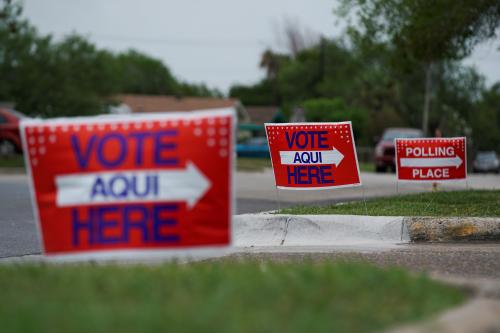Something very strange happened Thursday when the Census Bureau recommended against adjusting the 2000 totals to correct for the undercount of millions of individuals. After a years-long debate over whether science or politics should govern the way we conduct our decennial head count, the issue suddenly seemed moot. In the case of Census 2000, “science” unexpectedly converged with politics to produce an outcome that, as it happens, will also produce good policy.
Democrats, civil rights leaders and other supporters of adjustment, who had long argued that the decision about whether to adjust should be made by statistical experts and not politicians, were caught flat-footed by the bureau’s recommendation. Having appealed to the supposedly higher authority of scientific experts, proponents were reduced to silence when those experts delivered a verdict that went against their political interests.
Some critics have suggested that the recommendation was merely a GOP-influenced decision to keep minority counts from rising and thus protect Republican congressional seats. It is true, as the Democrats claim, that when Commerce Secretary Donald L. Evans accepts the bureau’s recommendation this week, as he’s virtually certain to do, he’ll be making a fundamentally political decision. But Democrats are disingenuous to suggest that only science is driving their support for adjustment. When it comes to the census and the search for the most accurate numbers, there’s no such thing as a scientific silver bullet.
Say what adjustment proponents will, the census is a fundamentally political endeavor. The push to characterize it as a scientific one is of fairly recent vintage. It was only in 1996 that the Census Bureau asserted that “incorporating widely accepted scientific statistical methods into Census 2000 will produce a better census.” Its current Web site features a banner referring to itself as “the longest continuous scientific project in American democracy.” Wrapping the census in the mantle of science was an about-face, made in response to criticism of the 1990 minority undercount and to the pro-adjustment stance of the Clinton administration. It was a far cry from a decade ago, when the bureau meekly described itself as “fact-finder for the nation.”
But the science angle worked for Democrats and civil rights groups, who could argue that adjustment was a disinterested solution to the undercount problem. It was in the spirit of that argument that William Daley, in one of his last acts as Clinton’s commerce secretary,handed the final decision about adjustment over to the director of the Census Bureau. Daley claimed he was eliminating politics from a decision that should be “made by the experts, based on sound, statistical science.” Of course, what he really did was hand the decision to another political appointee. The next day, Daley himself resigned to chair the Gore presidential campaign. So Democrats didn’t have much of a leg to stand on when they protested Evans’s recent “political” decision to take back the final word on adjustment.
None of this politicking would have surprised the Framers, who understood the census as an inescapably—and properly—political undertaking. The census was, as originally stipulated in the Constitution, was to be used both to levy direct taxes on the states and to apportion congressional representatives among them. The former would encourage states to minimize their population totals, the latter to maximize them. Self-interested politics was the mechanism by which impartial results would be achieved.
Throughout the 19th century, Congress routinely got involved in the wording of specific census questions.And the practice continues. Today, census professionals openly acknowledge the direction they receive from their political superiors—especially in the controversial area of racial and ethnic data-gathering. Former associate census director Conrad Taueber has noted that the Hispanic question on today’s census was originally forced onto the 1970 long form—at the last minute and over objections—by a Nixon White House making a play, even then, for the emerging Hispanic vote.
Eight years later, during the Carter administration, the Hispanic question was moved to the 1980 short form (mailed to all households), and a New York Times headline declared: “Census Questions on Race Assailed as Political by Population Experts.” Our memory of such matters is short. Today, proposals to eliminate or even amend these same questions are routinely denounced as “political” intrusions on the “scientific” prerogatives of Census Bureau professionals.
Yet the fact remains that census categories are inherently political constructs. After all, racial and ethnic identities are not like apples growing on trees?they are shaped, even generated, by political forces. As the National Academy of Sciences reminds us: “There is no scientific basis for the legitimacy of race or ethnicity as taxonomic categories.”
To be sure, there is such a thing as “scientific sampling.” But it is hardly foolproof. Just recall the recent presidential election, where contradictory survey results before the vote were followed by the exit poll fiasco. Exit polls provide a good model because, like them, census adjustment would rely on statistical models based on assumptions prone both to error and to political bias.
But one need not question the political motives of statisticians. In 1991, the adjustment process produced several sets of adjusted numbers, any one of which would have arguably been better than the unadjusted data. Yet each alternative would have produced different political winners and losers. Deciding which to use was a necessarily political decision for which statistical science could provide no guidance.
“Sampling” is in fact a misnomer that adjustment advocates cleverly smuggled into the debate in order to trade on the science of survey statistics. But adjustment is hardly a simple survey. Sampling means drawing inferences from a part to a larger whole—extrapolating upward. Adjustment, by contrast, means comparing two sets of results—the actual census and a post-census survey of about 300,000 households—extrapolating sideways. By attempting to match the responses of the same individuals to both surveys, statisticians seek to deduce who was missed (or counted twice) in the original count.
This process, called dual-system estimation, is a cutting-edge challenge for statisticians, which is no small reason why they have pushed for it, at least until last week. But it is also a logistical nightmare, which is why it has been opposed by those in the bureau responsible for operations.
“Statistical adjustment” is hardly a precisely controlled laboratory procedure performed by white-coated technicians. Over the months between the census and the post-census survey, people move, die or disappear. Individuals who avoid the census also avoid the survey. If found, they typically forget necessary details. Because the census cannot rely on identifiers such as Social Security numbers, this matching process is highly error-prone. And enumerators make mistakes recording data.
As the Census Bureau acknowledges, adjustment actually introduces new error. In 1991, the bureau’s adjusted numbers overestimated the undercount by 1 million people. Had then-Commerce Secretary Robert Mosbacher decided to use those numbers, Pennsylvania would eventually have unjustifiably lost a congressional seat to Arizona. And almost certainly it would have been necessary to adjust the adjusted numbers.
The census has been doing a good, if not perfect, job, and it has improved on its past performance. Last spring, it actually reduced the undercount of minorities from 1990 levels. Part of the credit goes to those who expressed concerns about the minority undercounts. But that doesn’t make them right about adjustment, which, quite apart from partisan self-interest, would be bad policy, reducing people’s incentives to participate in the original census and thus producing a much less accurate head count.
The Census Bureau’s decision was the right one—not merely from the partisan angle of Republicans, but from the perspective of the experts, and certainly that of public policy. As former census director Kenneth Prewitt acknowledged, it was “the prudent thing to do.”
But this decision should also serve as a reminder that it is a mistake to pursue political goals by evading politics, and by turning to science for answers to what are fundamentally political questions. As they anticipate Census 2010, advocates of adjustment should keep this in mind: Trying to rid the census of politics is like trying to rid horse racing of competition. Such efforts will only exacerbate public cynicism and erode confidence in one government agency that happens to be doing a good job.
Peter Skerry teaches political science at Claremont McKenna College. His book, Counting on the Census? Race, Group Identity, and the Evasion of Politics, was recently published by the Brookings Institution, where he is a senior fellow.



Commentary
Dressing It Up as Science Can’t Disguise the Politics
March 4, 2001